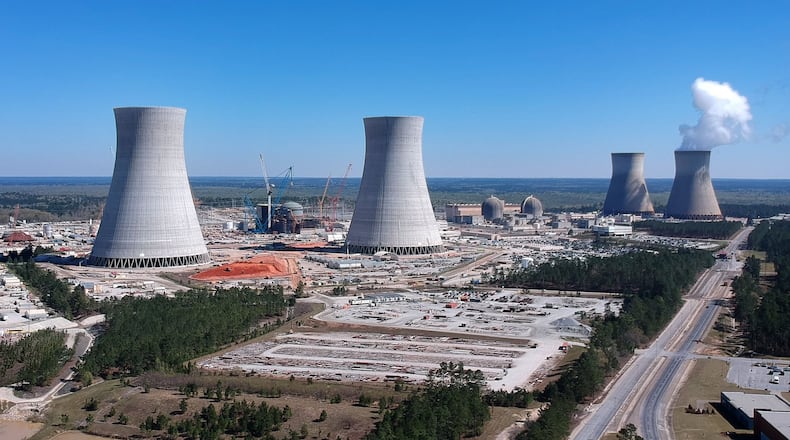Consumers may end up paying for billions of dollars in cost overruns on the Plant Vogtle nuclear expansion.
But for Georgia Power and its parent Southern Co., the extra costs could represent a huge financial windfall: billions of dollars in extra profit.
That’s because the electric utility’s profit from the sprawling project is tied largely to how much it spends, not whether it stays within budget.
The tab for 2.6 million Georgia Power customers — and the profit for Southern and its shareholders — could start becoming clearer this fall, when elected state regulators hold hearings to determine how much of Vogtle’s initial construction expenses can be added to electric bills for the first time.
By state law, Georgia Power can charge its customers for reimbursement of “prudent and reasonable” capital costs, such as from building a new plant, and for profit set as a percentage of those expenses. The higher the allowed costs, the greater the profit.
The Georgia Public Service Commission, which regulates the electric monopoly, could rule that many of Vogtle’s cost overruns weren’t prudent or reasonable, sharply limiting increases in consumer bills and reducing Georgia Power’s total profits.
But so far there are no indications that will happen, at least not in the long term.
Stock analysts, bond-rating agencies and the company’s own executives cite the risk, but they also often praise regulators’ “constructive” relationship with Georgia Power. In late 2019, the PSC agreed to let Georgia Power collect one of the highest rates of return among its peers around the nation.
“Their decisions, for lack of a better term, have been protective of or supported investments of Georgia Power,” said Jeff Cassella, a senior credit officer for bond-rating firm Moody’s Investors Service. He said he’s seen no indication the PSC will deny Vogtle costs.
Had Georgia Power met its original budget and schedule, it would have made $7.4 billion in profits on the project, according to testimony of state independent monitors and PSC staff. But because costs have soared by billions of dollars, those profits could rise to $12.6 billion over the decades-long life of the two new reactors under construction, they testified in 2017.
Costs at Vogtle have continued to climb since 2017. As a result, profits could rise higher, too.
Georgia Power spokesman Jeff Wilson didn’t directly address Atlanta Journal-Constitution questions about the likely total long-term profit impact from the company’s cost overruns. But in an email he wrote that profits would be tied to the utility’s significant investments “to serve Georgia’s energy future with a safe, reliable, carbon-free resource for the next 60 to 80 years.”
He said the company has recorded more than $1 billion in charges to its bottom line as a result of Vogtle’s higher costs. The company and PSC vice chairman Tim Echols cite temporary cuts to the profit rate the company is allowed to make on the project as long as delays continue to grow, until one or both of the new reactors are operational.
Critics of the project say those short-term financial penalties represent only a fraction of the extra profits Georgia Power and Southern stand to reap over decades from the higher costs.
Massive project more than five years behind schedule as costs balloon
Described as the largest construction project in state history, Vogtle’s expansion is led by Georgia Power and co-owned with not-for-profit partners, including affiliates of electric cooperatives and municipal utilities. The addition could power more than 500,000 homes and businesses.
The two new reactors — being built near two existing ones — would be the first commercial nuclear reactors built from scratch in the United States in the last 30 years. Vogtle’s expansion, nestled in the countryside 30 miles south of Augusta, put it at the forefront of what the industry predicted would be a nuclear renaissance for the nation.
But the expected U.S. rush to nuclear stumbled, undercut by falling prices for competing energy, stagnating power demands and soaring nuclear construction prices. In South Carolina, a nuclear project nearly identical to Vogtle was canceled midstream in 2017.
Vogtle’s expansion, meanwhile, has been riddled with problems and delays since the PSC approved the project in 2009. The company negotiated a contractor deal with Westinghouse to insulate the utility and customers from some of the worst of the possible overruns, but that was negated after Westinghouse filed for bankruptcy protection.
Georgia Power’s share of the initial estimated total project cost, $6.1 billion, has ballooned to $11.1 billion at the latest estimate.
The reactors were supposed to go into operation in 2016 and 2017, but the timetable has been repeatedly extended. Now, Georgia Power predicts the first unit will be finished in the first quarter of next year. A monitor for the state, though, says the earliest would be the summer of 2022, followed by the second reactor a year later, at best. And he cautioned that construction costs for Georgia Power and its partners could rise another $2 billion.
Credit: HYOSUB SHIN / AJC
Credit: HYOSUB SHIN / AJC
Project enjoyed big federal, state backing from beginning
Vogtle supporters say the project will offer a long-term source of electricity that is more reliable than solar and wind power. It also won’t emit carbon dioxide, unlike facilities that rely on natural gas or coal. Proponents hope it illustrates how nuclear energy can play a bigger role in limiting climate change.
PSC staff and advisers, though, also say the Vogtle’s new reactors will cost customers more over their 60-year life than if carbon-emitting, natural gas-burning units had been built instead.
Vogtle was set up for streamlined U.S. regulatory approvals, billions of dollars in federal loan guarantees and dibs on hundreds of millions of dollars in federal tax credits. Georgia’s legislators and then-Gov. Sonny Perdue allowed the company to collect financing costs and some profits years before any electricity was produced.
As a result, the average Georgia Power residential customer will have paid $854 toward the project before it goes into operation. That doesn’t include the actual costs of construction, which keep growing.
“It’s morally indefensible for Georgia Power to profit so obscenely from broken promises,” said Kurt Ebersbach, a senior attorney at the Southern Environmental Law Center, which represents some organizations opposed to customers paying for Vogtle’s overruns.
In an email to the AJC, he called the project “an enormous boon” to company shareholders and “a significant strain on customer wallets” that will last decades.
Echols, the PSC’s vice chairman, said in an email that the enactment of short-term profit reductions shows the regulator is holding the company accountable and “sends a painful and embarrassing message to Georgia Power.”
Those cuts essentially last until the first new reactor goes into operation. Then profit rates can rise back up for what could be decades to come, dwarfing the initial penalties.
Even before the PSC approved the project more than a decade ago, regulatory staffers and outside groups warned about steep price increases, as had occurred years earlier when Georgia Power built Vogtle’s original reactors. But PSC commissioners bucked a staff recommendation early on to enact risk-sharing measures that would reduce Georgia Power’s long-term profits if it busted its own budget.
Georgia isn’t alone in allowing regulated utilities to potentially profit on project overruns. A number of other states in the Southeast operate under a similar framework, according to the National Association of Regulatory Utility Commissioners.
But regulators can create extra protections for ratepayers. Mississippi’s PSC enacted cost caps on a coal gasification plant proposed by a Georgia Power sister company, Mississippi Power, more than a decade ago. The project went way over budget. Rather than getting lots of added profits from its customers, parent Southern faced billions of dollars in expenses.
About the Author
Keep Reading
The Latest
Featured



